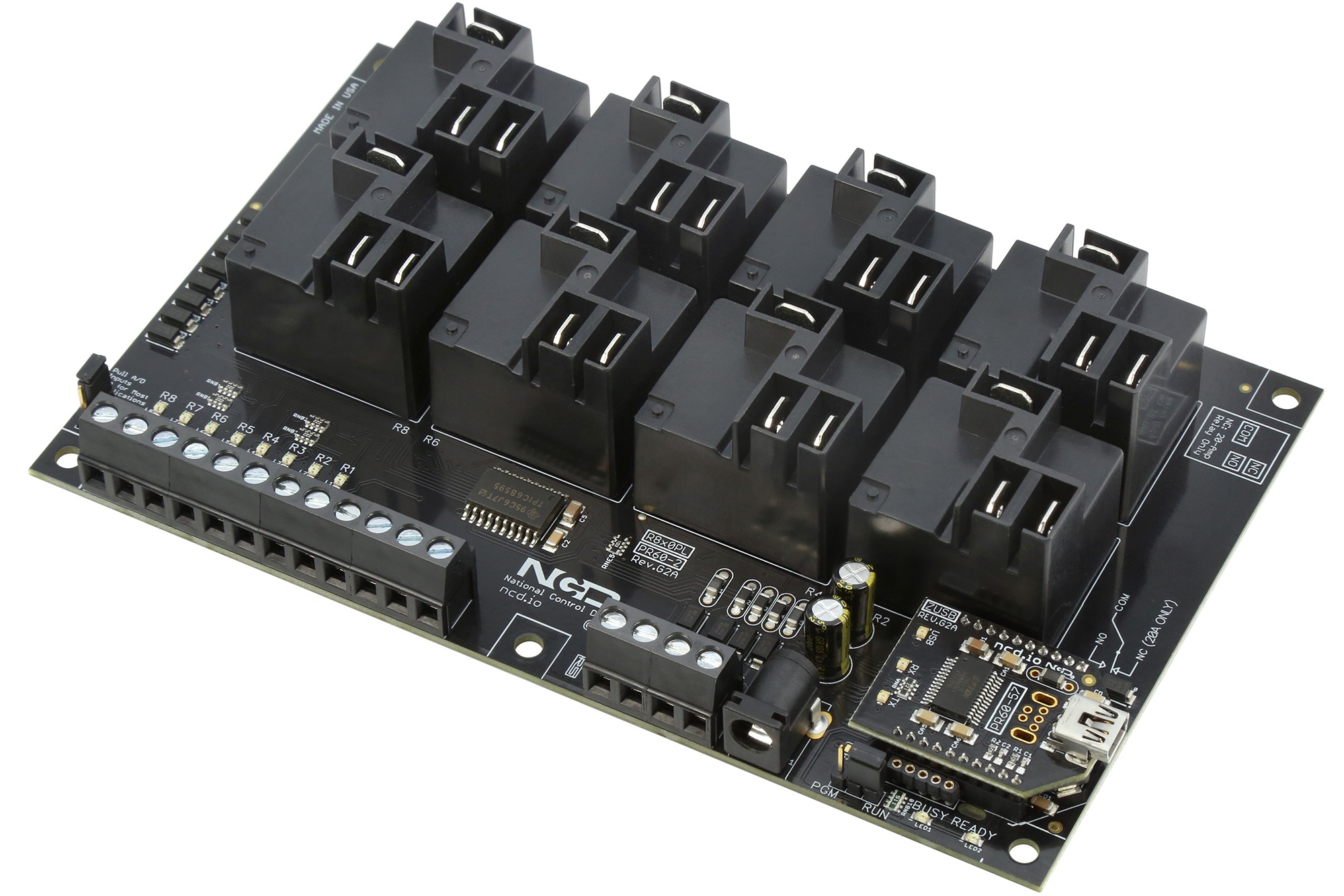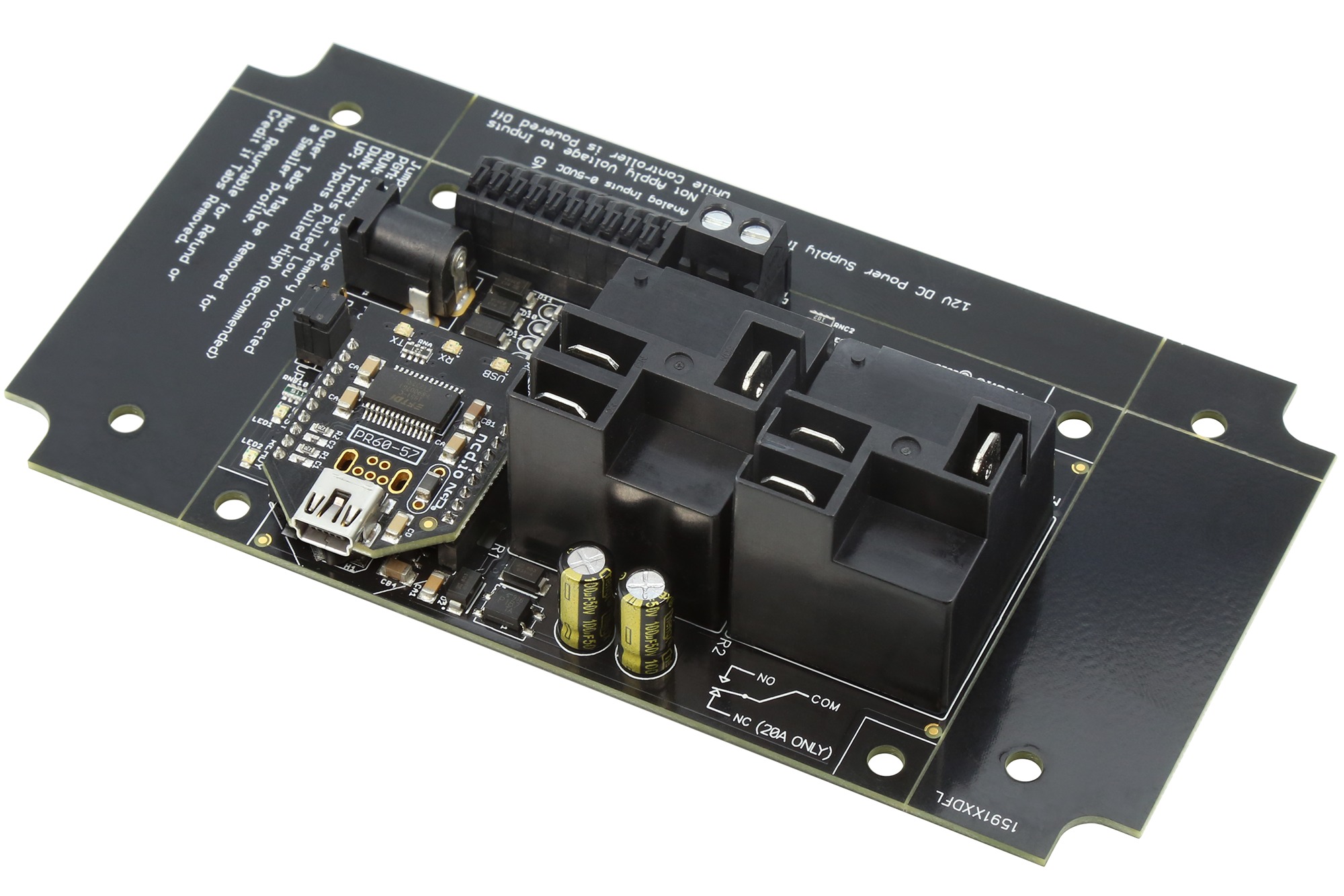USB Relay Controller with High Power Relays
Highlights
- Industrial Quality USB Relay Controllers
- Available with 1, 2, 4, or 8 On-Board Relays
- Available with 20 or 30-Amp Relays
- UpTo 8 Analog Inputs or Digital IO
- ProXR Command Set Used by Industry for Many Years
- Supports Windows, Mac, Linux, and Android
- Supports LabVIEW and Visual Studio
- Virtual COM Port Communications
- Use NCD Base Station Software to Learn Commands
- Analog Digital Inputs Ideal For Data Acquisition applications
USB Relay Devices from NCD
Our USB Relay products make it easy for computers of all types to control relays and monitor analog inputs. USB Relay boards allow you turn relays on or off, flash relays continuously, control relays for a duration of time, and control relays in groups using a cross-platform compatible USB interface. NCD ProXR Lite series controllers are a widely adopted standard used by industry for many years. Equipped with your choice of 1, 2, 4, or 8 on-board relays, the ProXR Lite series USB Relays suit the needs of most of our customers. Integrated Analog to Digital Converters may be used to manually control the relays, or they may be used to read external sensors. Equipped with 8 or 10-Bit resolution, the ADC built into NCD USB Relays add tremendous flexibility for various application requirements.
This device includes a NCD USB Interface module which will mount as a Virtual COM port on your computer. Simply Open the COM port at 115.2K Baud and start communicating. The USB interface is compatible with all Windows, Linux, Mac, and Android operating systems. Most systems do not require a driver; however, we use FTDI interface chips in our products and drivers are available from their web site if required for your system (www.ftdichip.com).Getting Started with an NCD USB Relay Module
Start by downloading Base Station at https://ncd.io/start. Plug in one of our USB relay boards and run Base Station. This software tool is designed to teach you all the features built into your controller and provide you with example commands. NCD USB Relays mount as a virtual COM port on your PC. Simply choose the new COM port and click OK to begin communicating with the USB Relay board. Base Station was written for Windows using Visual Studio (source code available). Base Station shows you all the commands you need for controlling relays and monitoring external sensors.
New Version Now Shipping
Beginning Late 2020, we’ve made some updates to this product to make it better with increased component count while maintaining the same functionality and footprint. The New Rev G2 Series adds a better power supply circuit to improve noise immunity while providing increased power to the communications socket. We also improved the relay drive circuit to better handle inductive loads. We also changed the color of the circuit board to Black and updated the branding to ncd.io with updated logos.
This is the same product you have been buying for years, but now with improved electronics and while maintaining the same footprint as the original design. Most importantly, this is now a Legacy product, which means it will never go obsolete as long as critical parts are still available to us. Built with our new high-speed pick and place assembly line, we can complete the surface mount assembly process at a rate of several thousand units per day with the potential to scale to any volume you could imagine, so you never need to worry about supply quantities or supply chain problems.
Please note that it was necessary for us to remove the integrated temperature sensor in select versions of this product. This sensor was providing incorrect readings if the relays were active for extended periods of time. We can help you with an off-board sensor if needed.
Updated Features
- Updated Logos and Branding, Changed PCB Color to Black
- Improved Relay Drive Circuit for Greater Noise Immunity
- Improved Power Supply Circuit
- Switcher Regulator for Lower Heat and Higher Power
- Adds Compatibility with NCDD5500 Ethernet Module
- Adds Compatibility with WiFi/Bluetooth Module
- Use MQTT to Talk to this Device via WiFi Module
- Use Integrated Web Page when using our New Ethernet or WiFi Module
- Added Zip Tie Holes to Secure Communications Module
- New Option for Pluggable Connectors on the Analog Inputs
- Ferrite Beads for Improved Noise Separation of Logic and Drive Circuits
- Updated LEDs to Address Supply Chain Limitations
- 100% Identical Firmware with No Changes for Drop In Compatibility
- 99% Identical Shape – Only Slight Changes to Connector Positioning
- Built by our High-Speed Pick and Place Machine for High-Volume Runs
- Legacy Status Product – Will Not Become Obsolete
- Removed Temp. Sensor from Select Versions due to Errant Readings
Base Station Software
Base Station Software was designed to help you learn the ProXR command set. Explore ProXR features using our Graphical User Interface. Watch data bytes flow to and from the board, so you easily understand the command execution process. There is no faster or easier way to learn how to automate than Base Station, as it was designed to work with our complete array of communication modules, including Wireless, Ethernet, USB, RS-232, and many more. You only need a Windows 8 or 10 Computer to Run Base Station. Base Station was written in Visual Studio, and we even provide the source code to help you on your way! Learn More about Base Station Software Here.
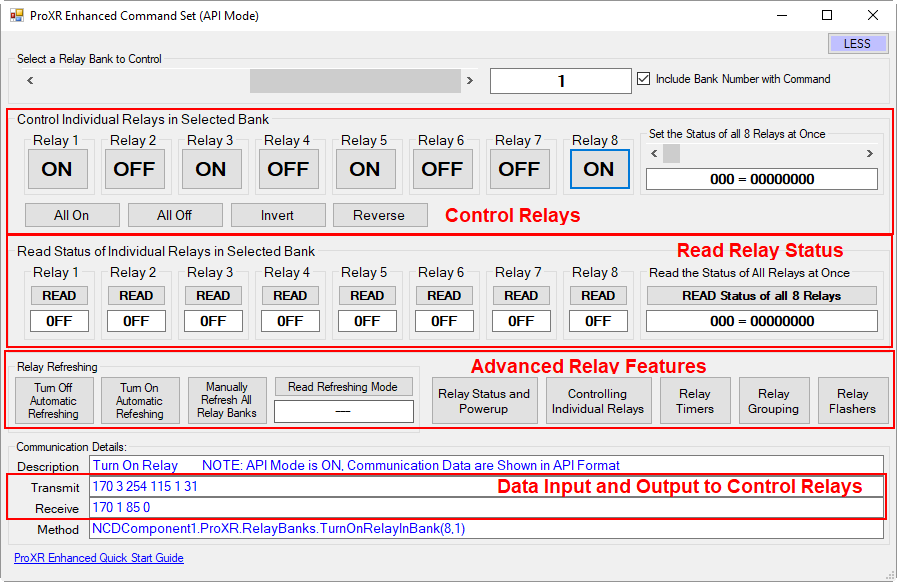
AD8 8-Channel 8/10-Bit Analog to Digital Converters
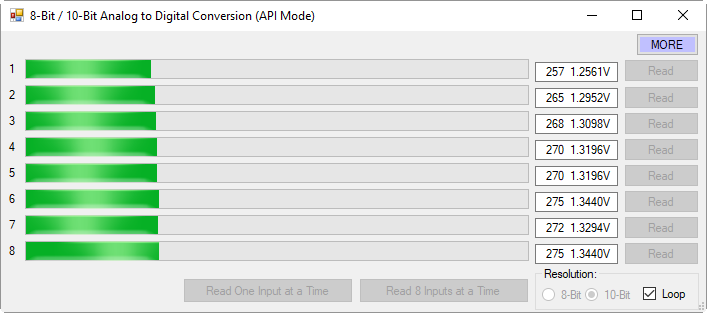
This controller is equipped with 8-Channels of 8/10-Bit Analog to Digital Converters, capable of reading analog voltages from 0 to 5 Volts DC. The ADCs on this controller allow monitoring of external sensors or contact closure input detection. Connect external temperature sensors, light sensors, current sensors, buttons, switches, or anything else that generates a 0-5VDC analog or contact closure output. With 8-bit resolution, analog inputs will convert 0-5 Volt signals into a value from 0 to 255. With 10-bit resolution, values of 0 to 1023 may be measured. Input resolution is software selected. Simply ask the controller for the analog value of each input, and the controller instantly responds.
Relay Activator and Analog Inputs
The Relay Activator control panel allows analog inputs to directly control relays. Simply connect the analog inputs to buttons or switches and trigger basic relay on or off functions to take manual control of the on-board relays. The Relay Activator control panel allows you to define 8 functions for each of the 8 inputs. Functions include turning relays on or off, toggling the state of relays, momentarily flash a relay, momentarily toggle the flashing function of a relay, turn all relays on, turn all relays off, and push notification events. When push notification events are configured, the controller generates a packet of data every time the inputs change state.
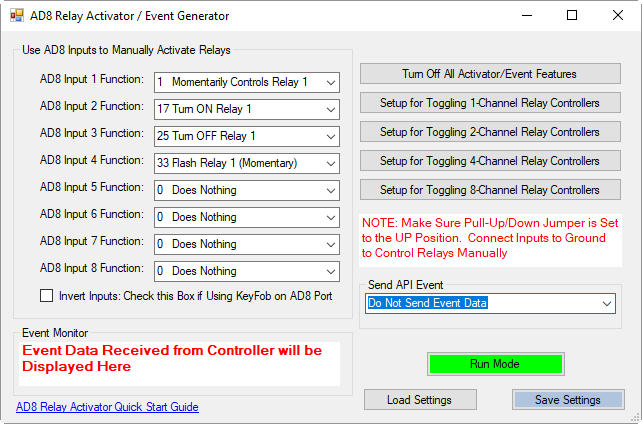
Learn More about ProXR Series Controllers
Base Station helps you learn how to use ProXR Series relay controllers. In this video, we will cover some of the most commonly used features.
Download Base Station
Download the Latest Version of Base Station and Source Code for Visual Studio.
ProXR Quick Start Guide
Online Manual for ProXR and ProXR Lite Series Controllers
Good to Know!
NCD ProXR Series Controllers have been in production for many years and have amassed a large user base since their initial release in the early 2000s. Due to the large client base, we have no plans to discontinue this line of products. In many cases, we are upgrading these devices to make them compatible with automated assembly processes along with improved driver and power electronics capable of supporting many communication technology changes well into the future. Rest assured, ProXR will continue to be a stable part of our product line for many years to come. ProXR series controllers manufactured with a Black circuit board have been migrated to automated assembly and are considered to be the final iteration of this product. These devices can be manufactured in high volumes in a much shorter period of time.
LabVIEW Relay Control
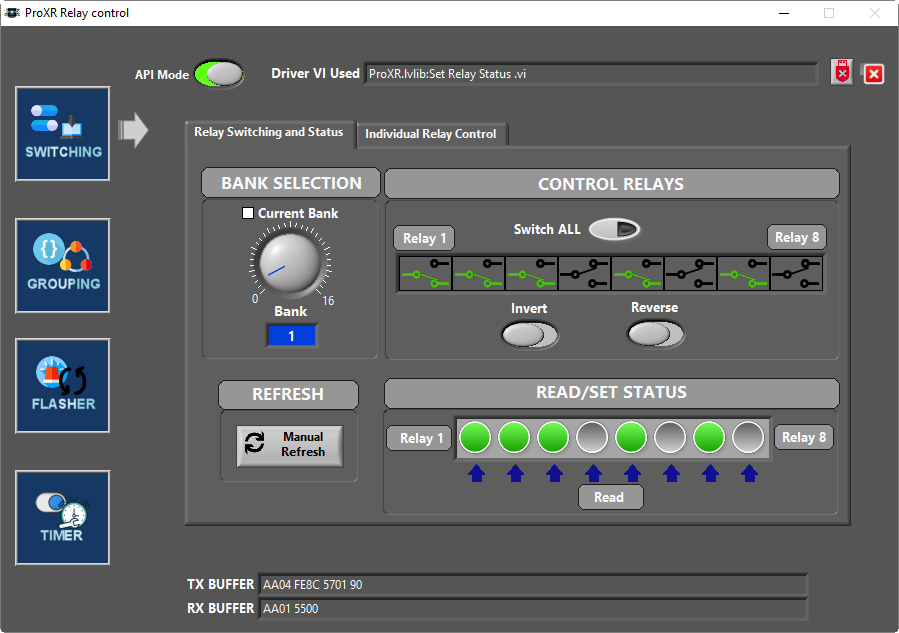
NCD supports integration of NCD relay controllers using LabVIEW. We have included samples and drivers for basic and advanced operation which cover most functions including Relay Timers. We have posted several tutorials on this topic here.
ProXR Lite Communication Options
We take communications seriously, as we believe in modular communications and firmware that properly supports scalability into future interface technologies. ProXR controllers support API communications, which effectively wrap every command with a header, payload, and checksum to ensure reliability. NCD API commands increase processing speed because no serial timeout is required prior to command processing. NCD API commands increase reliability, as only a proper checksum will authenticate a command and allow it to process. When we first implemented API, internet communications via a TCP/IP socket could be realized because the timing problems of internet communications were eliminated. While API is optional, it is strongly advised. Our Base Station software uses API communications, so it’s possible to control a ProXR controller over the internet after configuring port forwarding on your router.
ProXR series controllers are the world’s most adaptable controllers, capable of communicating with a wide variety of communication options. Pick any of your favorite communication technologies: Bluetooth, USB, WiFi, Ethernet, Key Fob, RS-485 or RS-232. ProXR easily adapts to the communication technologies you need most. We are committed to modular communications, so your ProXR series controllers can easily be retrofitted for other applications as your needs change. ProXR controllers are never obsolete, as we are actively releasing new communication technologies that greatly enhance the connectivity of our ProXR series controllers.
Communications Module Included
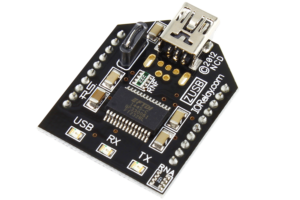
USB Communications Module
Our USB interface module makes it easy to control our devices using the USB port. Simply plug into any available USB port and start controlling our devices using standard serial commands. NCD USB Interface modules feature genuine FTDI USB to Serial Converter Chips, the very best in the industry. Learn more about our USB Communications module here.
Associated Part Numbers
This product may have been previously manufactured using a part number shown below:
Relay Options
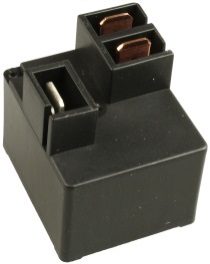
20-Amp SPDT High Power Relay Option
This controller is available with a 20-Amp relay option, allowing control of high-power loads up to an absolute maximum of 240VAC at 20 Amps. Ideal for high-power switching applications, this relay should never be used for low-power signals. The 20-Amp relay is of the SPDT variety, which provides Common (C), Normally Open (NO), and Normally Closed (NC) connections. Common is connected to NC when the relay is off. Common disconnects from NC and connects to NO when the relay is activated. This relay is Rated at 20-Amps between NO and C. Do not exceed 10-Amps between C and NC connections. This relay uses .250″ Quick Connect terminals (optional accessory) to connect to the top side of the relay. The relay is molded with COM, NC, and NO markings into the plastic. Review Datasheet
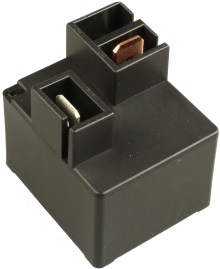
30-Amp SPST High Power Relay Option
This controller is available with a 30-Amp relay option, allowing control of high-power loads up to an absolute maximum of 240VAC at 30 Amps. Ideal for high-power switching applications, this relay should never be used for low-power signals. The 30-Amp relay is of the SPST variety, which provides Common (C) and Normally Open (NO) connections. Common has no connection when the relay is off. Common connects to NO when the relay is activated. This relay uses .250″ Quick Connect terminals (optional accessory) to connect to the top side of the relay. The relay is molded with COM, NO markings into the plastic. Review Datasheet
Mechanical Drawing
Wiring Diagrams
Essential
- ProXR Quick Start Guide
- Mechanical Relay Types
- API Codec Quick Start Guide
- Base Station Quick Start Guide
Documentation
Communications
Tutorials
- Unable to Mount Virtual COM Port in Windows 10
- Using Comm Operator to Control USB Relays
- Choosing the Right USB Relay Controller
- Controlling Inductive Devices: Managing Induction & Electromagnetic Interference
- Introduction to Computer Controlled Relays and Switching
- Relay Logic
LabView Tutorials
- Installing LabVIEW USB RS232 RS485 Relay Controller Instrument Driver
- Labview Relay switching and Status acquisition 1
- LabVIEW Relay Controller Advanced Configuration
- LabVIEW Relay controller Basic Configuration
- LabVIEW Relay switching and Status acquisition 2
- LabVIEW Relay Timer Operation
Official Repository
USB Intro
We explain the advantages and disadvantages to USB communications and how it effects our Relay Controllers and your application. Some of the information is outdated as we’ve moved away from controlanything.com. Most modern operating systems come with the FTDI driver installed so you should just need Base Station
USB FTDI Communication Module Compatible with the Digi XBee ® Controlling Relay
FT232RL USB Interface Adapter Similar to the Digi XBee ® footprint shown controlling a 16-Channel Relay Controller Board Available from https://store.ncd.io/product/usb-communications-module-ft232rl-zusb/ Drivers Available from FTDI: http://www.ftdichip.com/FTDrivers.htm Base Station Software: ncd.io/start Digi.com offers a wide variety of XBee Interface modules for industrial wireless applications. Digi XBee® devices are compatible with NCD products.
USB Setup
Learn how to set up you own ZUSB Module to work with your NCD Relay Controller. For complete instructions and details on how to use an NCD ZUSB Module see our article at https://ncd.io/zusb-usb-communications-module-quick-start-guide/ Portions of this video may be outdated as we have moved from controlanything.com since this video was created.
Finding the Com Port
Learn how to find the COM Port on your windows based computer. You can also use Base Station to find the COM Port of your Relay Controller. Base Station can be downloaded at ncd.io/start.
Analog to Digital Converter Introduction
Learn the Basics of Analog to Digital Conversion. Many of our boards have analog to digital inputs directly on the board. These ADC inputs are great for monitoring sensors and controlling relays from software based on these sensor readings. This video will show you how, why, and when to use them.
Wired Communications
Get the rundown on the pros and cons of all the Wired Communication Interfaces we offer. If you want to know which wired technology will best suit your needs this video will get you the information you need in just a few minutes. Whether you need the power of ethernet or the simplicity of RS-232 we have something to fit your application.
Introduction to Relay Control
This video will guide you in determining which relay controller you need for your application as well as a general overview of the differences between Relay Options. If you’re new to our products or just need a refresher for a new application this is a great place to start.
Induction Suppression
Learn about Induction and how it comes into play with Relay Controllers. Induction suppression can make your Relay Control applications intermittent and unreliable. This video will show you what causes it, how to avoid it, and how to account for it in your application.
Hiph-Power Relay Controller Specifications
This table covers all NCD High-Power Relay Controllers. All ratings assume 12VDC operation at 70°F (21°C). Please note that most ratings are estimated and may be subject to periodic revision. Some ratings represent stock controller settings without performance enhancement optimizations. The estimated processing time can be impacted by background services and choice of commands. Standby power consumption assume no communications module is installed and no relays are active on the controller. Please add the power consumption of the activated relays and communications module to obtain a better estimation of power consumption.| Specifications of NCD SPDT Relay Controllers | Minimum | Nominal | Maximum | Notes |
|---|---|---|---|---|
| Operational Voltages | 10VDC | 12VDC | 15VDC | |
| Standby Power Consumption | 35mA | 100mA | 200mA | No Active Relays, No Com Module |
| Relay Power Consumption | 28mA | 35mA | 60mA | Consumption of Each Activated Relay |
| Operational Temperature Range | -40°F (-40°C) | 70°F (21°C) | 185°F (85°C) | Theoretical Component Limits Shown |
| Storage Temperature Range | -67°F (-55°C) | 70°F (21°C) | 185°F (85°C) | Theoretical Component Limits Shown |
| Operational Ambient Air Humidity | 0% | 50% | 70% | Non-Condensing Humidity Values Shown |
| Relay Activation Time | 15ms | Component Rating Shown | ||
| Relay Deactivation Time | 10mS | Component Rating Shown | ||
| Operational Life Mechanical | 10,000,000 | Component Operation Rating | ||
| Operational Life Electrical | 100,000 | Component Rating at Maximum Load |
Communication Module Specifications
This table covers all NCD Communication Modules. While NCD communication modules operate at 3.3VDC, the ratings below highlight the effect they will have on the master controller operating at 12VDC at 70°F (21°C). Maximum ratings should be used for power budget planning purposes and may reflect short term absolute maximum peak current consumption. Some ratings are estimated and subject to periodic revision.| Specifications of NCD Communication Modules | Minimum | Nominal | Maximum | Notes |
|---|---|---|---|---|
| Operational Temperature Range | -40°F (-40°C) | 70°F (21°C) | 185°F (85°C) | Theoretical Component Limits Shown |
| Storage Temperature Range | -67°F (-55°C) | 70°F (21°C) | 185°F (85°C) | Theoretical Component Limits Shown |
| Operational Ambient Air Humidity | 0% | 50% | 70% | Non-Condensing Humidity Values Shown |
| USB Communications Module Power Consumption | NA | NA | NA | USB Modules are Powered by the USB Port Do Not Consume Device Current |
| RS-232 Communications Module Power Consumption | 10mA | 20mA | ||
| RS-485 Communications Module Power Consumption | 20mA | 35mA | ||
| Ethernet Communications Module Power Consumption | 58mA | 82mA | 100mA | |
| WiFi Bluetooth USB Communications Module Power Consumption | 37mA | 50mA | 100mA | Up to 300 Foot Indoor Wireless Range, Unobstructed. Up to 50 Foot Range Through Walls. |
| 900MHz Wireless Communications Module Power Consumption | 13mA | 30mA | 50mA | Up to 1,000 Foot Indoor Wireless Range, up to 2 Mile Outdoor Wireless Range using Included Antennas. Up to 28 Miles Outdoor Wireless Range using High-Gain Antennas. |
| 868MHz Wireless Communications Module Power Consumption | 17mA | 30mA | 50mA | |
| 2.4GHz Wireless Communications Module Power Consumption | 8mA | 20mA | 30mA | |
| KFX Wireless Key Fob Communications Module Power Consumption | 11mA | 15mA | 25mA | Up to 200 Feet Outdoor Wireless Range using 1, 2, 3, 4, or 5 Button Key Fobs. Up to 700 Feet Outdoor Wireless Range using 8-Button Remotes. |
AD8 Analog Input Usage Notice
Analog Inputs should not have a voltage present when powered down. Use a 220 Ohm current limiting resistor on each input to prevent damage to the controller if voltage will be present on the analog input when this controller is powered down. Do not exceed 0 to 5VDC on any analog input or the on-board CPU will be damaged. Most analog inputs include a 10K Pull Up/Down resistor to help keep the inputs quiet when not in use. This 10K resistor may slightly bias the readings of some sensors.


